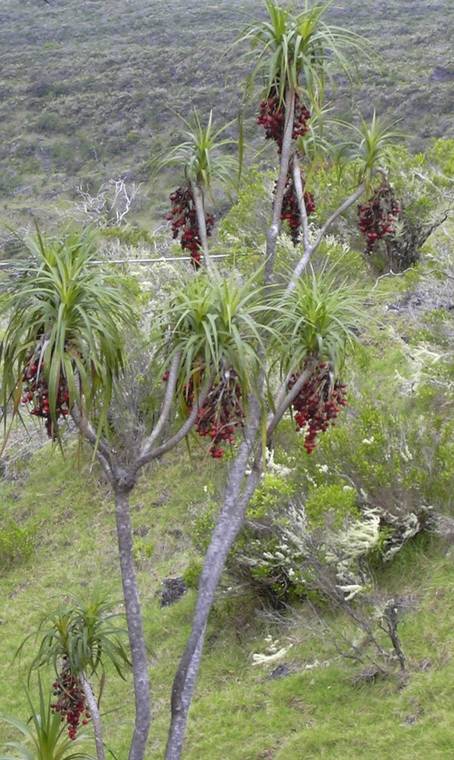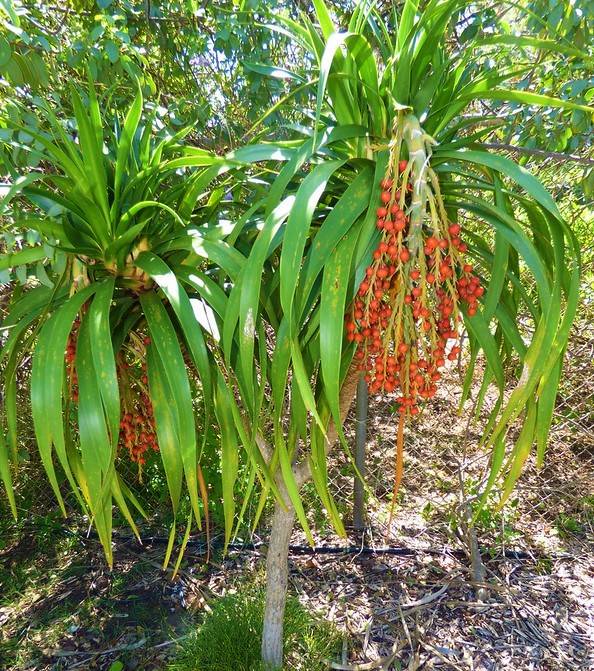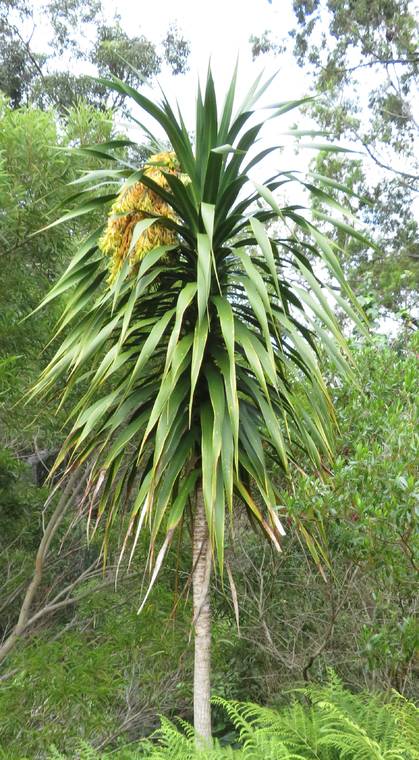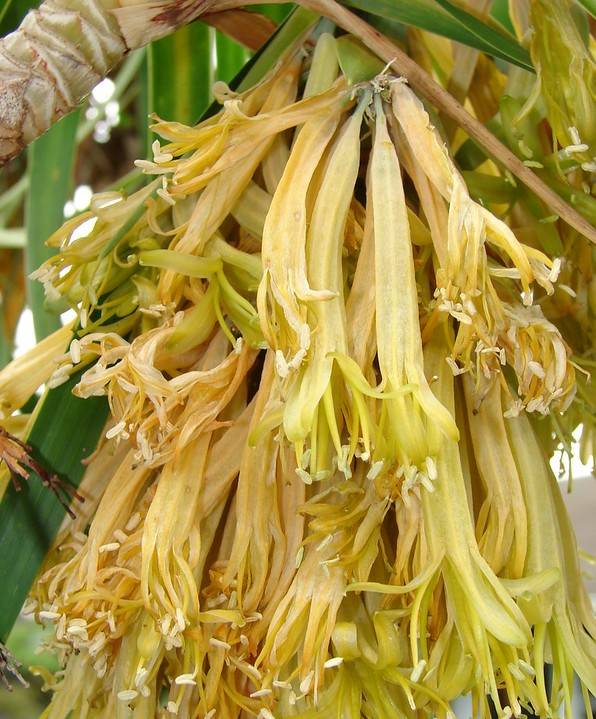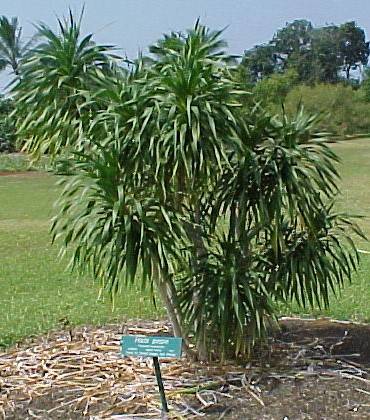Planting the rare and delightful native Hawaiian plant hale pepe can add an interesting and lovely specimen to your garden or landscape. As botanists continue to change and update the classification of plants, hale pepe’s order, family and genus have changed several times. As a member of the Aspargales order, the Agavaceae family and part of the Dracaena genus it has many relatives that we already grow in our gardens. Asparagus, agave, ti plants and dracaenas are all related to hale pepe. It is the only one among her relatives that is native to Hawaii, however.
Though hala pepe was classified hale pepe in the Pleomele genus in the past, it has recently been reclassified into the Chrysodracon genus, perhaps as a sub-genus of Dracaena. This generic name derives from the Greek words “chrsyo” for gold and “dracon” for dragon. This is doubtless a reference to the unique golden flower display unique to this species.
When naming this plant, the ancient Hawaiians saw the similarities between this species and the hala or screw pine in the Pandanus genus. Though the two plants are not related, their similar leaf shape appears to be the reason for the hala name to be used in hala pepe.
To add to the naming confusion, slightly different species appear on each Hawaiian island. Chrysodracon hawaiiensis is endemic to Hawaii Island while the smaller species C. forbesii is endemic to Oahu along with another species C. halapepe. Maui, Molokai and Kauai also have their own slightly different species that are endemic to their island.
Regardless of her various names and classifications, this plant has a lot to recommend it to local gardeners. Perhaps its most appealing characteristic is its drought tolerance. For those with small gardens, hale pepe’s slow growth is also appealing.
The large inflorescence of yellow pendant flowers that blooms in spring is a striking sight. The bright green tufts of strap-like leaves also add to its allure. Though the tree can grow to 20 feet or more, it’s slow growth habit make it possible to control the height as well as its spread with judicious pruning.
The slender leaves of the hala pepe look like green pom poms at the end of the gray branches of the tree. The flower, which appears at the plant’s whim, is a large drooping panicle of golden blossoms arranged in clusters. The showy inflorescence is followed by the hale pape’s dark red berries. The fruit of this plant contains brown seeds that turn orange at maturity, usually in the fall.
Hale pepe’s seeds do not store well as they have a high water content. If you let them dry on the tree, they can be stored a bit longer. Otherwise, planting them soon after collection and cleaning will result in a better germination rate. The best planting medium is one that drains well and holds very little moisture. A combination of vermiculite and perlite works well.
The seeds should sprout in less than six weeks. Remember, this is a monocot. It will sprout as a single upright leaf. Though the young seedlings will need some water, hale pepe is very drought tolerant and needs to be in a medium that drains well and is watered infrequently.
Transplant them from the seeding tray to a larger pot once they have a few pairs of leaves. They may grow to ten inches within six months as long as they are not overwatered or overfed. Choose a spot to plant out hala pepe that gets full sun and has soil that drains well. It is best to wait until they are large and strong before planting them out. Snails, slugs, rats or mice can eat the soft bark and cause lethal damage.
Very few pests or diseases attack hale pepe. Overhead watering could cause leaf spotting. Water at the soil level rather infrequently as they are getting started. Be careful not to overwater as they plant is susceptible to root rot. As they mature they may be fine with no water except in drought conditions.
Hala pepe’s leaves, bark and roots were used medicinally by ancient Hawaiians and the soft wood was used for carvings. The flowers were also used to make lei. Hala pepe is sacred to Laka, the Hawaiian goddess of the hula. Hula halau traditionally placed a branch of hala pepe on their altar to include her in their rituals.
This interesting species does grow slowly, but is a beautiful native Hawaiian plant and well worth cultivating. Since the Hawaii Island native, C. hawaiiensis, is endangered, be sure that you acquire that hala pepe species legally. Otherwise, you can plant a different species. A friend with a few seeds might be helpful or a nursery may have plants or seeds. Peter Van Dyke from Amy Greenwell Garden reports having seen hala pepe on occasion at some of the big box stores but none are available at the Garden currently. Call around or get Margo from Sunrise (640-9191) to look for one for you. Hopefully your search will be rewarded with a lovely hala pepe for your landscape.
Diana Duff is a plant adviser, educator and consultant living parttime in Kailua-Kona. This article was reviewed for accuracy by Peter Van Dyke, manager of Amy Greenwell Ethnobotanical Garden.
Gardening Events
Andrea Kawabata will begin resuming on-farm visits to assist commercial coffee and orchard crop farmers. Social distancing and masks will be required. If you would like to schedule a farm visit, make an appointment by emailing andreak@hawaii.edu, calling 808-322-4892, or texting 415-604-1511.
Farmer Direct Markets:
Since this information is constantly changing, it is best to check with individual markets to see how they are dealing with the Covid-19 shutdown and gradual reopening.
Some market vendors have formed huis for ordering online and curbside pickup. Some markets are open with masks and social distancing required. Once information about the markets is received here, it will be listed.
Plant Advice Lines
May resume soon. You can email questions to konamg@ctahr.hawaii.edu or himga@hawaii.edu






